The final steps to meeting NFPA 25 inspection timelines for dry sprinklers
Dry sprinkler systems are specially designed to offer reliable automatic fire protection in freezing temperatures. But once installed, regular inspection is essential to keeping them in proper working order.
In the previous installment of our series on dry sprinkler systems, we explained the National Fire Protection Association (NFPA) requirements for daily, weekly, and monthly inspections. In this blog, we will take a look at best practices for quarterly and annual inspections, as well as those that happen farther out than a year.
Be sure to check out other pieces in this dry sprinkler series:
A Guide to Dry Sprinkler Systems, Part 1: System Overview
A Guide to Dry Sprinkler Systems, Part 2: Components and Installation Requirements
A Guide to Dry Sprinkler Systems, Part 3: Installation of Components
A Guide to Dry Sprinkler Systems, Part 5: Daily, Weekly, and Monthly Inspection Requirements
Are you looking to buy components for your building’s sprinkler system? QRFS offers a range of dry sprinkler heads available on special order. Simply give us a call at 888.361.6662 or email support@qrfs.com.
You can also view our in-stock selection of sprinkler gauges, valves, supervisory switches, and other accessories.
NFPA 25 requires extra inspections for dry sprinklers
The 2017 edition of NFPA 25: Standard for the Inspection, Testing and Maintenance of Water-Based Fire Protection Systems establishes minimum requirements for the periodic inspection of dry sprinkler systems. Dry sprinklers eliminate the risk of burst pipes that render wet sprinklers unreliable in freezing temperatures by filling non-heated pipes with pressurized air or nitrogen that holds back the water supply at a main dry valve. When heat from a fire causes one or more sprinklers to activate, the air pressure drops and the valve opens, releasing the water into the pipes and onto the fire.
But while dry sprinklers solve an important problem for property owners, their unique components and regular exposure to freezing temperatures make them more complex to properly install and maintain. With this in mind, NFPA 25 mandates extra inspection requirements for dry systems to ensure they’re ready to operate when they’re needed most.
Sprinkler inspections require trained technicians to visually evaluate system components for physical damage that would prevent them from working properly. While it’s vital to follow specific manufacturer instructions, NFPA 25 provides timelines for how often inspections should take place on each part. Let’s jump into this rundown of longer inspection deadlines:
Quarterly dry sprinkler inspections: waterflow alarms, supervisory devices, electrically-supervised control valves, and water tanks
Quarterly inspections involve waterflow alarms that sound when water movement is detected, water storage tanks, electrically-supervised control valves, and supervisory devices that monitor system status and indicate abnormal conditions that might impact operation. All system components included in daily, weekly, or monthly inspections should be checked again during quarterly inspections as well.
Quarterly inspection of waterflow alarms
From the 2017 edition of NFPA 25
5.2.4 Waterflow alarm and supervisory signal initiating devices shall be inspected quarterly to verify that they are free of physical damage.
Quarterly inspection of electrically-supervised control valves and supervisory devices
13.3.2.1.2 Valves that are electrically supervised shall be permitted to be inspected quarterly.
13.3.2.1.3 Control valve supervisory alarm devices shall be inspected quarterly to verify that they are free of physical damage.
Quarterly inspection of fire pumps
For systems that rely on fire pumps, NFPA 25 requires a handful of parts to be inspected every three months. But many other components of a fire pump assembly don’t need to be inspected more than annually.
8.1.1.2.7 Fuel tanks, float switches, and supervisory signals for interstitial space shall be checked quarterly for liquid intrusion.
8.1.1.2.12 Engine crankcase breathers shall be checked quarterly.
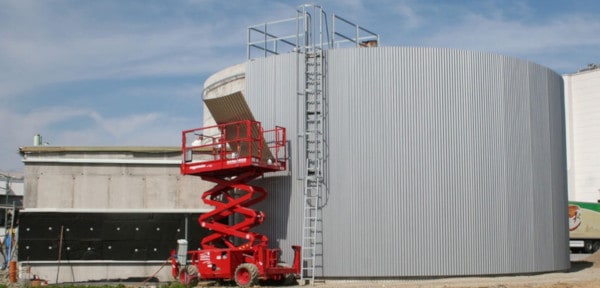
Quarterly inspection of water tanks
When water tanks supply water to dry sprinkler systems, NFPA 25 requires quarterly checks of water levels unless supervisory water level alarms are not installed. In those cases, inspections must be performed monthly.
A.9.2.1.1 also recommends more frequent inspections during colder months. Water temperature can still be checked quarterly if low temperature alarms are present, otherwise it must be inspected weekly during the colder months.
9.2.1.1* The water level in tanks equipped with supervised water level alarms that are supervised in accordance with NFPA 72 shall be inspected quarterly.
9.2.1.2 The water level in tanks not equipped with supervised water level alarms connected to a constantly attended location shall be inspected monthly.
9.2.2.1 Tank heating systems installed on tanks equipped with low water temperature alarms supervised in accordance with NFPA 72, connected to a constantly attended location shall be inspected quarterly during the heating season.
9.2.2.2 Tank heating systems without a supervised low temperature alarm connected to a constantly attended location shall be inspected daily during the heating season.
9.2.3.1 The temperature of water in tanks shall not be less than 40°F (4.0°C).
9.2.3.2 The temperature of water in tanks with low temperature alarms supervised in accordance with NFPA 72, connected to a constantly attended location shall be inspected and recorded quarterly during the heating season when the mean temperature is less than 40°F (4.0°C).
9.2.3.3 The temperature of water in tanks without low temperature alarms connected to a constantly attended location shall be inspected and recorded weekly during the heating season when the mean temperature is less than 40°F (4.0°C).
9.2.4.1* The exterior of the tank, supporting structure, vents, foundation, and catwalks or ladders, where provided, shall be inspected quarterly for signs of obvious damage or weakening.
9.2.4.2 The area surrounding the tank and supporting structure, where provided, shall be inspected quarterly to ensure that the following conditions are met:
(1) The area is free of combustible storage, trash, debris, brush, or material that could present a fire exposure hazard.
(2) The area is free of the accumulation of material on or near parts that could result in accelerated corrosion or rot.
(3) The tank and support are free of ice buildup.
(4) The exterior sides and top of embankments supporting coated fabric tanks are free of erosion.
Annual inspections: sprinkler heads, pipes, bracings, fire pump assemblies, more water tank check-ups, and signage
Annual inspection of dry sprinkler heads
NFPA 25 requires an annual visual inspection “from the floor level” of sprinkler heads. Inspectors must look out for damage, leakage, incorrect orientation of a sprinkler, missing sprinklers or components, and proper clearance between sprinkler heads and any objects.
Also check for loading, aka a build-up of dust or sediment on the sprinkler. If a mildly loaded sprinkler is found, it can be cleaned without touching it (per NFPA requirements) with a special tool. If loading is heavy, the sprinkler must be replaced.
From the 2017 edition of NFPA 25
5.2.1.1 Sprinklers shall be inspected from the floor level annually.
5.2.1.1.1* Any sprinkler that shows signs of any of the following shall be replaced:
(1) Leakage
(2) Corrosion detrimental to sprinkler performance
(3) Physical damage
(4) Loss of fluid in the glass bulb heat-responsive element
(5) Loading detrimental to sprinkler performance
(6) Paint other than that applied by the sprinkler manufacturer
5.2.1.1.2 Any sprinkler that has been installed in the incorrect orientation shall be corrected by repositioning the branchline, drop, or sprig, or shall be replaced.
The annual inspection also involves making sure that the stock of replacement sprinklers and tools is adequate—though there is an exception for systems with dry sprinklers of different lengths. These spare dry sprinklers are not required, so long as “a means of returning the system to service is furnished.”
From the 2017 Edition of NFPA 25
5.2.1.4 The supply of spare sprinklers shall be inspected annually for the following:
(1) The correct number and type of sprinklers as required by 5.4.1.5
(2) A sprinkler wrench for each type of sprinkler as required by 5.4.1.5.5
(3) The list of spare sprinklers as required by 5.4.1.5.6
5.4.1.5* A supply of at least six spare sprinklers shall be maintained on the premises so that any sprinklers that have operated or been damaged in any way can be promptly replaced.
5.4.1.5.1 The sprinklers shall correspond to the types and temperature ratings of the sprinklers in the property.
5.4.1.5.3 Where dry sprinklers of different lengths are installed, spare dry sprinklers shall not be required, provided that a means of returning the system to service is furnished.
5.4.1.5.4 The stock of spare sprinklers shall include all types and ratings installed and shall be as follows:
(1) For protected facilities having under 300 sprinklers — no fewer than 6 sprinklers
(2) For protected facilities having 300 to 1000 sprinklers — no fewer than 12 sprinklers
(3) For protected facilities having over 1000 sprinklers — no fewer than 24 sprinklers
5.4.1.5.5* One sprinkler wrench as specified by the sprinkler manufacturer shall be provided in the cabinet for each type of sprinkler installed to be used for the removal and installation of sprinklers in the system.
Annual inspection of pipes
Pipes comprise the largest portion of a dry sprinkler system—and they also represent the biggest risk. Pipe corrosion can render an entire fire protection system useless, and many dry systems are especially prone to problems because the oxygen in the pressurized air that’s present during normal conditions is quick to react with any water trapped in the pipes due to condensation or testing. A growing trend toward replacing pressurized air in dry sprinklers with nitrogen significantly reduces the risk of corrosion.
Dry sprinkler pipes must also be perfectly pitched to avoid sitting water that can lead to microbiologically-influenced corrosion (MIC), pipe scale, or the formation of ice during freezing temperatures. Water trapped in the pipes has the potential to freeze and expand by about 10 percent, prompting micro-cracks once the temperature warms and the ice melts. Not only can these tiny cracks change the air pressure in the pipes and cause the dry valve to trip, but water that flows into the system will leak and eventually start gushing as the cracks enlarge.
To avoid these issues, pipe inspections should be scheduled before temperatures typically drop. Pipes that aren’t properly pitched should be fixed, preferably with drum drips installed. A.5.2.2.1 does allow for “a degree of judgment” about whether the extent of any surface corrosion discovered during an inspection warrants replacement of piping because it will impact the integrity of pipe strength or raise concerns of leakage.
5.2.2* Pipe and Fittings. Sprinkler pipe and fittings shall be inspected annually from the floor level.
5.2.2.1* Pipe and fittings shall be free of mechanical damage, leakage, and corrosion.
5.2.2.2 Sprinkler piping shall not be subjected to external loads by materials either resting on the pipe or hung from the pipe.
5.2.2.3* Pipe and fittings installed in concealed spaces such as above suspended ceilings shall not require inspection.
5.2.2.4 Pipe and fittings installed in areas that are inaccessible for safety considerations due to process operations shall be inspected during each scheduled shutdown.
5.2.3* Hangers, Braces, and Supports. Sprinkler pipe hangers, braces, and supports shall be inspected annually from the floor level.
5.2.3.1 Hangers, braces, and supports shall not be damaged, loose, or unattached.
5.2.3.2 Hangers, braces, and supports that are damaged, loose, or unattached shall be replaced or refastened.
5.2.3.3* Hangers, braces, and supports installed in concealed spaces such as above suspended ceilings shall not require inspection.
5.2.3.4 Hangers, braces, and supports installed in areas that are inaccessible for safety considerations due to process operations shall be inspected during each scheduled shutdown.
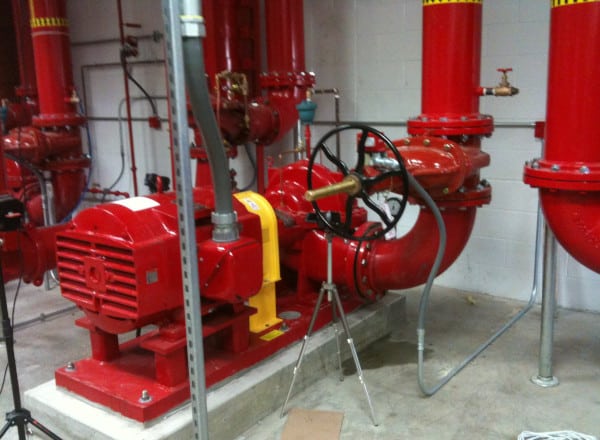
Annual inspection of fire pumps
Fire pump assemblies provide waterflow and pressure for fire protection systems. They include the pump, the water supply suction and discharge piping and valving, and any auxiliary equipment, as well as the electric, diesel, or steam turbine driver and control.
While NFPA instructs individuals responsible for inspection to consult the manufacturer’s specific instructions for fire pumps, its guidelines—which include checking bearings, circuit boards, wires, and so, so much more—serve as a key checklist:
8.1.1.2.1* Shaft movement or end play shall be checked annually with the pump operating.
8.1.1.2.2 Electrical connections shall be checked annually and repaired as necessary.
8.1.1.2.3 Pump and motor bearings and couplings shall be greased annually or as required.
8.1.1.2.4 Printed circuit boards (PCBs) shall be checked annually for corrosion.
8.1.1.2.5 Cable and/or wire insulation shall be checked annually for cracking.
8.1.1.2.6 Plumbing parts, both inside and outside of electrical panels, shall be checked annually for any leaks.
8.1.1.2.8 Supervisory signal circuitry shall be checked annually for high cooling water temperature.
8.1.1.2.9 Fuel tanks shall be checked annually for water and foreign materials.
8.1.1.2.10 Fuel tank vents and overflow piping shall be checked annually for any obstructions.
8.1.1.2.11 All flexible hoses and connections shall be checked annually for cracks and leaks.
8.1.1.2.13 Exhaust systems, drain condensate traps, and silencers shall be checked annually.
8.1.1.2.14 Back pressure on the engine turbos shall be measured annually.
8.1.1.2.15 Batteries shall be checked annually as follows:
(1) Checking the specific gravity, state of charge, and charger rates of the batteries
(2) Cleaning the terminals of any corrosion.
(3) Ensuring that the cranking voltage exceeds 9 V on a 12 V system or 18 V on a 24 V system
(4) Ensuring that only distilled water is used in batteries
8.1.1.2.16 All controls and power wiring connections shall be checked annually and repaired as necessary.
8.1.1.2.17 Lubricating oil in engines shall be changed every 50 hours of operation or annually.
8.1.1.2.18 Lubricating oil filters shall be changed every 50 hours of operation or annually.
8.1.1.2.19 The condition of sacrificial anodes shall be checked annually and replaced as necessary.
8.1.1.2.20 Circulating water filters shall be replaced annually.
8.1.1.2.21 The accuracy of pressure gauges and sensors shall be inspected annually and replaced or recalibrated when more than 5 percent out of calibration.
Annual inspection of water tanks
Most water tank components require quarterly inspections, but a few can be performed once a year, including expansion joints, hoops and grillage of wooden tanks, and exterior surfaces. To aid in the specific annual inspection for exterior degradation, it’s helpful for property owners to stencil the last-known date of interior paint jobs on the exterior of the tank in a conspicuous place, such as at eye level near a manway that provides access to the tank.
9.2.4.3 Expansion joints, where provided, shall be inspected annually for leaks and cracks.
9.2.4.4 The hoops and grillage of wooden tanks shall be inspected annually.
9.2.4.5 Exterior painted, coated, or insulated surfaces of the tank and supporting structure, where provided, shall be inspected annually for signs of degradation.
Annual inspection of signage
Signage inspections have a very practical and potentially life-saving purpose. For example, if a facility has multiple sprinkler risers, proper labeling proves invaluable when a fire department needs to shut a particular valve—especially if the risers share a common manifold. While a graphic diagram with color-coded areas of protection is most useful, NFPA 25 calls for property owners to at least include an information sign and a list of all low-point drains. A missed drain could easily lead to frozen piping and accidental system trips.
4.1.9.1 A permanently marked metal or rigid plastic information sign shall be placed at the system control riser supplying an antifreeze loop, dry system, preaction system, or auxiliary system control valve.
4.1.9.2 Each sign shall be secured with a corrosion-resistant wire, chain, or other approved means and shall indicate at least the following information:
(1) Location of the area served by the system
(2) Location of auxiliary drains and low-point drains for dry pipe and preaction systems
(3) The presence and location of antifreeze or other auxiliary systems
(4) The presence and location(s) of heat tape
Section 5.2.7 also requires information signs to be inspected annually to ensure they are available, securely attached, and legible.
Inspections that can be spaced out longer than a year: internal inspections of pipes, valves, and water tanks
NFPA 25 requires internal inspections of pipes, valves, and water tanks every five years, although the frequency increases to every three years for the interior of steel water tanks where corrosion protection can’t be verified. Non-metallic pipes are not subject to internal inspections because they are far less vulnerable to corrosion.
The primary goal of an internal inspection is to detect corrosion, but it can also uncover the presence of material that could cause obstructions in piping or sprinklers. Inspectors should look for signs of microbiologically-influenced corrosion (MIC), zebra mussels, inorganic materials like rust and scale, or materials accidentally left behind in pipes by installers like gloves and cut-out coupons.
Since internal inspections are best performed when the system is drained, it’s wise to coordinate all of them at once. NFPA 25 mandates that slime and tubercules, or small nodules attached to the inside of a pipe, are immediately tested for MIC, a leading cause of pipe destruction like pinhole leaks.
NFPA 25 calls for an obstruction investigation if “sufficient” foreign material is found during pipe inspections. But since it does not define the amount that would be “sufficient” to obstruct a pipe, inspectors must make a judgment call. A.14.2.1.4 states that small amounts of foreign materials like scale or rust inside a sprinkler pipe are normal and shouldn’t trigger an investigation.
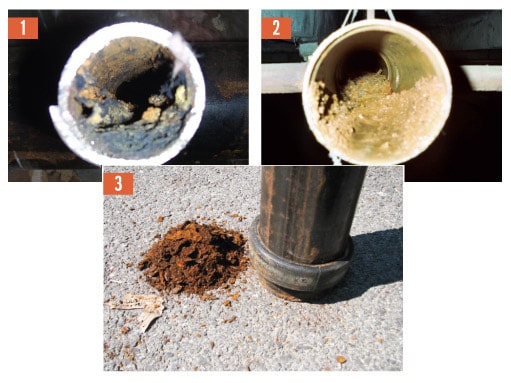
Longer inspection of water tanks
From the 2017 edition of NFPA 25
9.2.5.1.1* The interior of steel tanks without corrosion protection shall be inspected every 3 years.
9.2.5.1.2* The interior of all other types of tanks shall be inspected every 5 years.
9.2.5.2 Where interior inspection is made by means of underwater evaluation, silt shall first be removed from the tank floor.
9.2.5.3 The tank interior shall be inspected for signs of pitting, corrosion, spalling, rot, other forms of deterioration, waste materials and debris, aquatic growth, and local or general failure of interior coating.
9.2.5.4 Steel tanks exhibiting signs of interior pitting, corrosion, or failure of coating shall be tested in accordance with 9.2.6.
9.2.5.5* Tanks on ring-type foundations with sand in the middle shall be inspected for evidence of voids beneath the floor.
9.2.5.6 The heating system and components including piping shall be inspected.
9.2.5.7 The anti-vortex plate shall be inspected for deterioration or blockage.
Longer inspection of valves
13.4.3.1.4.1 Internal inspection of valves that can be reset without removal of a faceplate shall be permitted to be conducted every 5 years.
Longer inspection of pipes
14.2.1* An assessment of the internal condition of piping shall be conducted on a frequency determined by 14.2.1.1 or 14.2.1.2 for the purpose of inspecting for the presence of foreign organic and inorganic material.
14.2.1.1 An assessment of the internal condition of piping shall be conducted at a minimum of every 5 years or in accordance with 14.2.1.2 for the purpose of inspecting for the presence of foreign organic and inorganic material.
14.2.1.2* Where an assessment frequency has been established by an approved risk analysis, the assessment shall be performed at a frequency determined by the approved risk analysis.
14.2.1.3 Tubercules or slime, if found, shall be tested for indications of microbiologically influenced corrosion (MIC).
14.2.1.4* If the presence of sufficient foreign organic or inorganic material is found to obstruct pipe or sprinklers, an obstruction investigation shall be conducted as described in Section 14.3.
14.2.1.5 Nonmetallic pipe shall not be required to comply with Section 14.2.
14.2.2.2 If foreign organic and/or inorganic material is found in any system in a building, all systems shall be assessed.
Detailed records are required for dry sprinkler inspections
NFPA 25 (4.3.1) requires property owners to maintain thorough inspection records, including an “owner’s section” completed by the property owner or owner representative. Records should be kept at least a year after the next inspection so system condition and performance can be compared for signs of deterioration (4.3.5). Electronic record-keeping is acceptable (4.3.1.1).
From the 2017 edition of NFPA 25
4.3.2 Records shall indicate the following:
(1) The procedure/activity performed (e.g., inspection, test, or maintenance)
(2) The organization that performed the activity
(3) The required frequency of the activity
(4) The results and date of the activity
(5) The name and contact information of the qualified contractor or owner, including lead person for activity
Did a dry sprinkler inspection reveal a system deficiency? Fix it!
Of course, no matter how thoroughly inspections are performed, they mean nothing if the system deficiencies they identify aren’t corrected. At the end of the day, though contractors may find an issue and propose services that fix it, it is the property owner’s responsibility to ensure that dry sprinkler systems remain in tiptop shape, ready to protect people and property from fires in freezing temperatures.
Stay tuned for the next installments in our review of dry sprinkler systems and their applications, in which we’ll explore testing and maintenance requirements, and take an in-depth look at how to prevent corrosion. And check out our previous installments in this series:
A Guide to Dry Sprinkler Systems, Part 1: System Overview
A Guide to Dry Sprinkler Systems, Part 2: Components and Installation Requirements
A Guide to Dry Sprinkler Systems, Part 3: Installation of Components
A Guide to Dry Sprinkler Systems, Part 5: Daily, Weekly, and Monthly Inspection Requirements
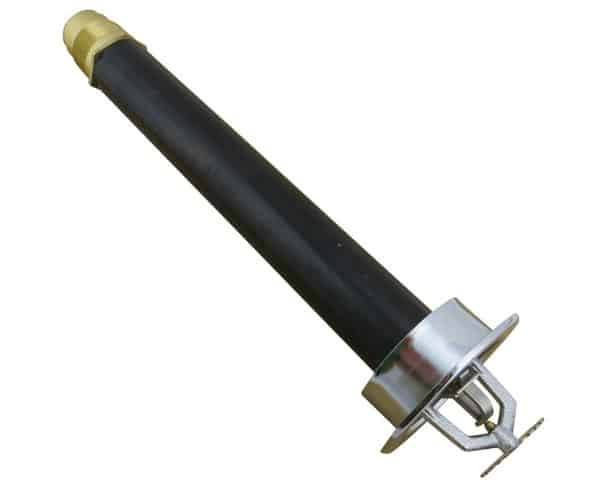
If you’re looking to buy components for your dry pipe sprinkler system, QRFS offers a range of dry sprinkler heads available on special order. Simply give us a call at 888.361.6662 or email support@qrfs.com and we’d be happy to help.
We also stock sprinkler gauges, valves, switches, and other accessories that are applicable in dry systems.


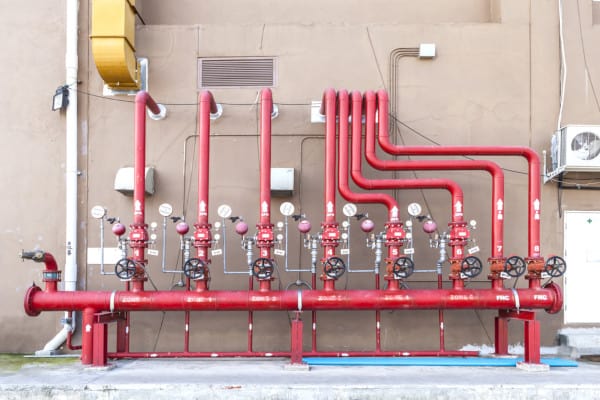
I live in a 9 unit condo building with small (6×10) open porches that have 10 dry pipe
sprinkler heads. No open flame BBQ is permitted. The building is 15 yrs old and the local Fire Dept is requiring system testing to conform with National Fire code 25. What is required?
Why do they need to open up the ceilings and create a 2×2 opening? Just seems like a waste of lot money.
Frankly, I dont understand why there is even a sprinkler requirement to a residential open
porch with virtually zero risk of combustion.
Mark — Based on the system type in a commercial residential building, your local codes apparently require regular inspection, testing, and maintenance to be conducted according to the rules in NFPA 25. Without knowing more specific information, we can’t comment on what NFPA 25 items require opening the ceilings. Your best bet is to ask the fire department or a sprinkler pro who is conducting the test what they are doing and its purpose for clarification. Thanks for reading!